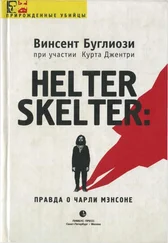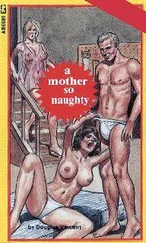MANSON“The version the man [indicating me] gave was right on. I am almost sure Mr. Kanarek knew that I had asked to see him. I had wanted to speak to this man for the last year, and it was my request that motivated it.”
As for the hearing itself, Manson said: “Your Honor, I don’t think this is fair at all. You know, this was my mistake.”
Agreeing, and ruling that there had been no impropriety involved, Judge Choate brought the hearing to an end.
The irony of all this was not lost on the press, which reported, with some incredulity, that Manson had taken the stand to defend the man who had convicted him of seven murders!
My interest in the sources of Manson’s beliefs stretched back to my assignment to the case. Some of those sources have been mentioned earlier. Others, though inadmissible as evidence in the trial, have more than a passing interest, if only as clues to the genesis of such a sick obsession.
I knew, from Gregg Jakobson and others, that Manson was an eclectic, a borrower of ideas. I knew too, both from his prison records and from my conversations with him, that Manson’s involvement with Scientology had been more than a passing fad. Manson told me, as he had Paul Watkins, that he had reached the highest stage, “theta clear,” and no longer had any connection with or need for Scientology. I was inclined to accept at least the latter portion of his claim. In my rather extensive investigation, I found no evidence of any kind that Manson was involved with Scientology after his release from prison in 1967. [87] One of Manson’s chief disciples, Bruce Davis, was very closely involved with Scientology for a time, working in its London headquarters from about November or December of 1968 to April of 1969. According to a Scientology spokesman, Davis was kicked out of the organization for his drug use. He returned to the Manson Family and Spahn Ranch in time to participate in the Hinman and Shea slayings.
By this time, he had gone on to do his own thing.
What effect, if any, Scientology had on Manson’s mental state cannot be measured. Undoubtedly he picked up from his “auditing” sessions in prison some knowledge of mind control, as well as some techniques which he later put to use in programming his followers.
Manson’s link with The Process, or the Church of the Final Judgement, is more tenuous, yet considerably more fascinating. The leader of the satanic cult is one Robert Moore, whose cult name is Robert DeGrimston. Himself a former disciple of Scientology founder L. Ron Hubbard, Moore broke with Scientology about 1963 to form his own group, after apparently attaining a high position in the London headquarters. He and his followers later traveled to various parts of the world, including Mexico and the United States, and for at least several months, and possibly longer, he lived in San Francisco. He also reportedly participated in a seminar at the Esalen Institute in Big Sur, though whether this coincided with any of Manson’s visits there is unknown.
One of DeGrimston’s most fervent disciples is one Victor Wild, a young leather goods manufacturer whose Process name is Brother Ely.
Up until December of 1967, Victor Wild’s residence, and the San Francisco headquarters for The Process, was 407 Cole Street, in Haight-Ashbury.
From about April through July 1967, Charles Manson and his still fledgling Family lived just two blocks away, at 636 Cole. In view of Manson’s curiosity, it appears very likely that he at least investigated the satanists, and there is fairly persuasive evidence that he “borrowed” some of their teachings.
In one of our conversations during the Tate-LaBianca trial, I asked Manson if he knew Robert Moore, or Robert DeGrimston. He denied knowing DeGrimston, but said he had met Moore. “You’re looking at him,” Manson told me. “Moore and I are one and the same.” I took this to mean that he felt they thought alike.
Not long after this I was visited by two representatives of The Process, a Father John and a Brother Matthew. Having heard that I was asking questions about the group, they had been sent from their Cambridge, Massachusetts, headquarters to assure me that Manson and Moore had never met and that Moore was opposed to violence. They also left me a stack of Process literature. The following day the names “Father John” and “Brother Matthew” appeared on Manson’s visitor’s list. What they discussed is unknown. All I know is that in my last conversation with Manson, Charlie became evasive when I questioned him about The Process.
In 1968 and 1969, The Process launched a major recruiting drive in the United States. They were in Los Angeles in May and June of 1968 and for at least several months in the fall of 1969, returning to England in about October, after claiming to have converted some two hundred American hippies to their sect. Manson was in Los Angeles during both periods. It is possible that there may have been some contact with Manson and/or his group, but I found no evidence of this. I’m inclined to think that Manson’s contact with the group probably occurred in San Francisco in 1967, as indicated, at a time when his philosophy was still being formulated. I believe there was at least some contact, in view of the many parallels between Manson’s teachings and those of The Process, as revealed in their literature.
Both preached an imminent, violent Armageddon, in which all but the chosen few would be destroyed. Both found the basis for this in the Book of Revelation. Both conceived that the motorcycle gangs, such as Hell’s Angels, would be the troops of the last days. And both actively sought to solicit them to their side.
The three great gods of the universe, according to The Process, were Jehovah, Lucifer, and Satan, with Christ the ultimate unifier who reconciles all three. Manson had a simpler duality; he was known to his followers as both Satan and Christ.
Both preached the Second Coming of Christ, a not unusual belief, except in their interpretation of it. According to a Process pamphlet: “Through Love, Christ and Satan have destroyed their enmity and come together for the End: Christ to Judge, Satan to execute the Judgement.” When Christ returned this time, Manson said, it would be the Romans, i.e., the establishment, who went up on the cross.
Manson’s attitude toward fear was so curious I felt it to be almost unique. At least I felt that until reading in a special issue of The Process magazine devoted to fear: “Fear is beneficial…Fear is the catalyst of action. It is the energiser, the weapon built into the game in the beginning, enabling a being to create an effect upon himself, to spur himself on to new heights and to brush aside the bitterness of failure.” Though the wording differs, this is almost exactly what Manson preached.
Manson spoke frequently of the bottomless pit, The Process of the bottomless void.
Within the organization, The Process was called (at least until 1969) “the family,” while its members were known as brothers, sisters, mothers, fathers.
The symbol of The Process is similar, though not identical, to the swastika Manson carved on his forehead.
Among the precepts of The Process which parallel Manson’s own: “The Time of the End is now…The Ultimate Sin is to kill an animal…Christ said love your enemy. Christ’s enemy was Satan. Love Christ and Satan…The Lamb and the Goat must come together. Pure Love descended from the Pinnacle of Heaven, united with Pure Hatred raised from the depths of Hell.”
One former Process member, being interrogated by LAPD in connection with two motorcycle gang slayings (neither of which was connected with The Process), said of the cult, “They don’t like anybody that they can’t indoctrinate or anybody that is not with them. They are just totally against what they call the ‘gray forces,’ the rich establishment or the Negroes—”
Читать дальше












